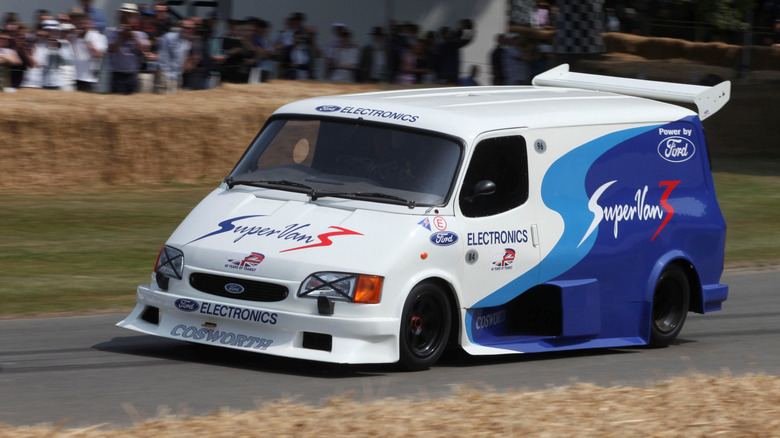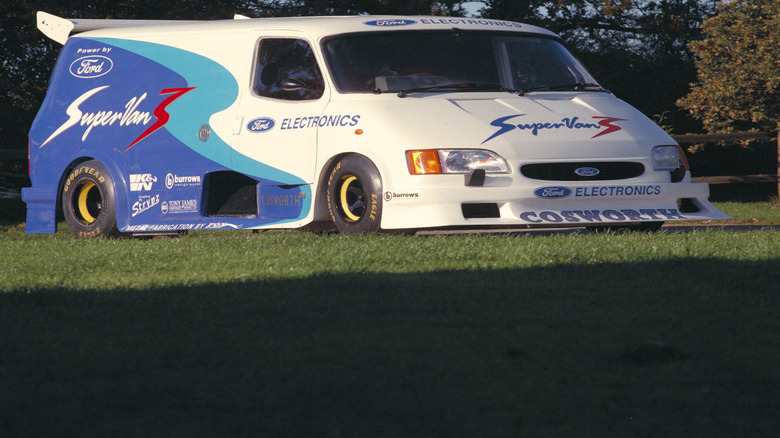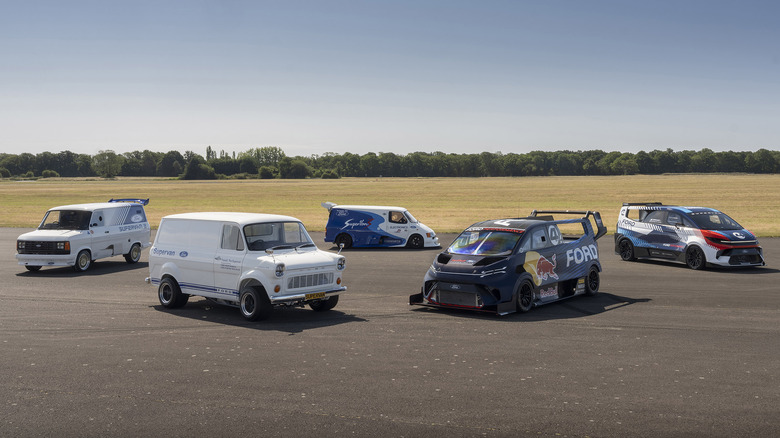Ford Supervan 3: Why Ford Put An F1 Engine In A Practical People Mover
There have been more than a few production cars with Formula 1 engines, although nearly all of them were quite expensive and exclusive. But decades before the likes of Aston Martin and Mercedes Benz built their F1-powered hypercars, two mainstream automakers combined a van body, race car chassis, and high-horsepower F1 engine on a very limited basis. One was Renault, which marked the 10th anniversary of the Espace minivan in 1995 by bringing its F1-tested 800 horsepower V10 to the one-off Espace F1. Back in 1971, Ford of Britain and Terry Drury Racing had built the Supervan as a promotional tool using the Transit body, a Cooper Monaco chassis, and a Ford 302 cubic inch V8 that made 435 horsepower.
When Supervan 2 came along in 1978, Ford switched to a 3.9-liter Cosworth V8 with roots in endurance racing. Supervan 3 arrived in 1994 in tandem with an updated Transit, and Supervan 3 buyers got a new 3.5-liter Cosworth V8 that made 650 horsepower and revved all the way to a very un-vanlike 13,000 rpm. Like its predecessors, the 180mph Supervan 3 was meant as a way to get people interested in Ford's everyday vans and served mostly as a promotional vehicle (pun intended).
The Supervan 3 wasn't used much
Supervan 3 got a top-to-bottom update from the previous version, including a fiberglass shell in place of the Transit's metal body and that Cosworth HB V8 engine. Supervan 3 looked ready to deliver flowers but screamed like a Formula 1 race car during its three-second 0-60 sprint. Unfortunately, Supervan 3's expensive powertrain required a team of mechanics to stay running and was limited to a few promotional gigs. The exotic Formula 1 engine was swapped out for a supercharged 3.0-liter V6 in 2005 for the Transit's 40th anniversary, and Ford brought the beast out again for the 2013 Goodwood Festival of Speed.
Although the Supervan 3 had a short and sheltered life, that wasn't the end of Ford's quest to make fast vans. In 2022, Supervan 4 appeared as a showcase for Ford's EV tech, and the potent all-electric race hauler has seen steady refinement since then. In August 2025, test driver Romain Dumas whipped the 2,000-horsepower Supervan 4.2 around Germany's Nurbringring in under seven minutes.
Ford's new partership with Red Bull could mean a new F1-engined Supervan
According to Ford, Dumas' time of 6:48.393 is faster than laps taken by a Porsche 911 GT3 RS and Chevrolet Corvette ZR1X on the same circuit. Unfortunately for fans of Ford vans and F1 tech, that lap is where the Supervan story leaves off. Although there have been no whisperings of an upcoming Supervan 5, Ford has the Mustang Mach-E and F-150 Lightning on which to base a new race-focused EV. With Ford returning to Formula 1 in partnership with Red Bull Racing in time for big changes to F1 engine regulations for 2026, fans are free to dream about Max Verstappen taking laps in a mashup of a Transit van body atop Red Bull's new racing chassis and engine. The Ford-Cosworth effort was good for multiple F1 championships with the likes of Lotus, McLaren, and Williams before Ford's last season as an engine supplier (with Jaguar in 2004). The Jaguar outfit was sold to Red Bull Racing, which later used Honda's F1 engines for many years.
Red Bull team principal Laurent Mekies outlined on the Formula 1 website how much work Verstappen is contributing to development of the new hybrid engine. "He certainly wants a fast car next year, and he's doing everything he can in the car and outside the car to help us give him that," Mekies said. The four-time F1 driver's champion is also making progress toward earning his Nurburgring Nordschleife license, and it would be a thrill to see him take aim at Dumas' remarkable lap time in a new Supervan.


